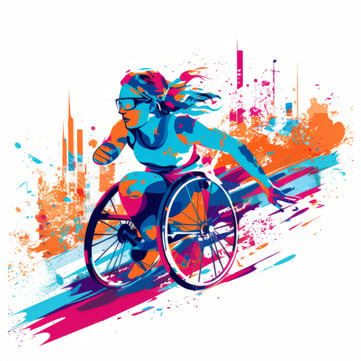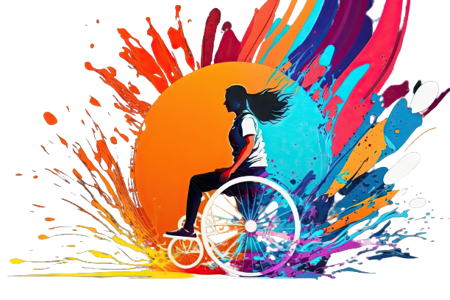7 Key Lessons from Spinal Cord Injury Rehab for Long-Term Care
Information overload is huge after a spinal cord injury even for the average person, especially if they aren’t used to medical jargon, much of the information doctors and nurses tell them about caring for their body after a spinal cord injury can go in one ear and out the other. Or they simply don't care because they're depressed.
The truth however is that most of the advice they give you is incredibly important and should be continued long after you leave the hospital. This will help you stay healthy on multiple levels, from maintaining your overall physical health to staying mentally healthy. See this crucial advice below.
1.) Range of Motion
One of the first self-care tips most people are taught after a spinal cord injury is range of motion. In fact, therapists will enter acute/ICU rooms to visit people with very new spinal cord injuries to begin this right away in order to avoid joint contractions, which are common among people with spinal cord injuries. Range of motion is a medical term for simply stretching the muscles throughout the body, from the legs to the arms to the hand range of motion for people with quadriplegia.
Therapists will instruct people with spinal cord injuries to do a range of motion twice a day for at least 5 minutes at a time. By maintaining your morning and evening stretches, you keep your body limber and you’ll be more able to maintain your abilities. With a spinal cord injury, any tight/contracting muscles can greatly limit movement.
Sadly, many people stop doing their range of motion after transitioning home after a spinal cord injury. This is due to not having enough time or not having enough assistance to perform said task. Also, range of motion can get boring but don't stop doing it. It’s one of the most important things you can do to maintain your body after spinal cord injury.
2.) Adaptive Sports
When going through spinal cord injury rehabilitation, most people are introduced to adaptive sports and recreational activities. Whether it's archery, sailing, rugby, or even sit-skiing, most spinal cord injury rehabilitation centers make it their mission to introduce people with new spinal cord injuries to as many adaptive sports as possible. The only problem is that when people return home they no longer participate or take interest in these sports.
Also staying involved in an adaptive sport or recreational outlet is a great way to maintain mental health. Being around people who truly understand where you're coming from, as well as staying involved in a competitive activity can be life-changing. But most importantly it is the camaraderie and socialization that is one of the most beneficial side-effects of adaptive sports.
3.) Use a Standing Frame Regularly
An amazing piece of exercise equipment that most people have access to when they're in spinal cord injury rehabilitation is a standing frame. This mobility device can help people with spinal cord injuries fully stand, helping with a myriad of health issues that can occur after a spinal cord injury from constipation to osteoporosis. Standing frames however are not cheap, but they can be covered by insurance so make sure to start there. Ideally, you should be using a standing frame at least once a week.
4.) Skin Checks
Pressure sores are common after a spinal cord injury. When you're newly injured, nurses will instruct you how to check your skin on a daily basis for any possible pressure sores or the beginnings of one. This is a critical task that must be done on a daily basis when living with spinal cord injury, so make sure to listen when you receive this lesson and do not stop your daily skin checks. Many people will stop checking their skin on a daily basis when going home and will instead only check it a few times a week. This however can be highly dangerous, since pressure sores can happen overnight.
In order to check your skin independently, make sure you have a handheld mirror so you can see every corner of your bum, and get in bed to do a skin check as well. If you see any red marks, keep your eye on these areas, as they could be the start of a pressure wound.
5.) Compression Stockings
Swelling of the feet aka edema is a very common occurrence after a spinal cord injury simply because sitting all day with your legs in a downward angle is not great for blood flow. And when you have a new spinal cord injury, one of the first things nurses will show you are compression stockings aka Ted hose, which are extremely tight stockings that help promote blood flow and prevent blood clots.
These stockings can sometimes be difficult to put on, however, which makes many people discontinue using them within the first year of their injury. But if you want to seriously prevent swelling and lessen your chances of getting a blood clot, always have a pair of compression stockings on hand.
6.) Weight Lifting & Cardio
When you go through spinal cord injury rehabilitation, therapists drive home weightlifting and regular exercise to make sure you get as strong as possible. When you’re in rehab, access to accessible exercise equipment makes it much easier to continue working out on a regular basis. Unfortunately, after many people are discharged, they no longer have access to these machines and stop working out altogether. Many people as a result lose strength in their arms.
Don't let this happen to you. It is recommended that people with spinal cord injuries workout at least 3 to 4 times a week in 20-minute increments. This is to make sure you maintain your cardio health. Many people with spinal cord injuries are in the danger category of good heart health. Consider investing in low-cost exercise equipment, like Theraband and Velcro wrist weights, that you can use for your home workout.
7.) Pool Therapy
Whether you call it aquatic therapy or water therapy, getting into a pool to exercise is one of the best ways to stay healthy after a spinal cord injury. Unfortunately, many people don’t have access to a pool after they’re discharged and they never do any kind of water therapy again. When some people do have the chance to return to water for therapy (check out local public pools such as the YMCA), many claim it can help with chronic pain and they love the gravity-free effects of the water that makes it easier to move.
Stay Updated on Advancements On Traumatic Brain &
Spinal Cord Injuries
About the Author




